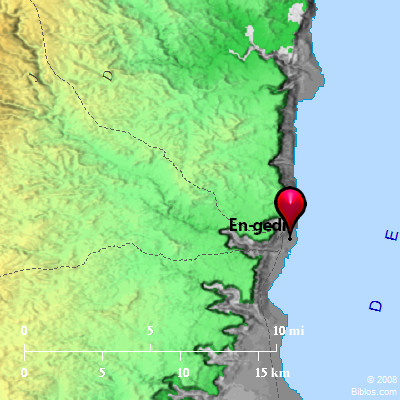Atlas  Engedi (En-gedi) and surrounding area
Maps Created using Biblemapper 3.0Additional data from OpenBible.infoOccurrences Joshua 15:62 Nibshan, the City of Salt, and En Gedi; six cities with their villages. 1 Samuel 23:29 David went up from there, and lived in the strongholds of En Gedi. 1 Samuel 24:1 It happened, when Saul was returned from following the Philistines, that it was told him, saying, "Behold, David is in the wilderness of En Gedi." 2 Chronicles 20:2 Then there came some who told Jehoshaphat, saying, There comes a great multitude against you from beyond the sea from Syria; and behold, they are in Hazazon Tamar (the same is En Gedi). Ezekiel 47:10 It shall happen, that fishermen shall stand by it: from En Gedi even to En Eglaim shall be a place for the spreading of nets; their fish shall be after their kinds, as the fish of the great sea, exceeding many. Encyclopedia EN-GEDIen'-ge-di, en-ge'-di (`en gedhi, "fountain of the kid"):
Identical with the present Ain Jidi. According to 2 Chronicles 20:2 it is the same as Hazazon-tamar, mentioned in Genesis 14:7 as occupied by the Amorites and as having been attacked by Chedorlaomer after leaving Kadesh and El Paran on his way to the Vale of Siddim. The place is situated upon the West shore of the Dead Sea about midway between the North and the South ends, and was included in the territory of Judah (Joshua 15:62). The spot is rendered attractive by the verdure clothing it by reason of immense fountains of warm water, 80 degrees F., which pour out from beneath the limestone cliffs.
In the time of Solomon (Songs 1:14) palms and vines were cultivated here. Josephus also mentions its beautiful palm groves.
In the time of Eusebius it was still a place of importance, but since the Middle Ages it has been almost deserted, being occupied now only by a few Arabs. The oasis occupies a small area a few hundred feet above the Dead Sea marked by the 650 ft. sedimentary terrace heretofore described (see DEAD SEA). The limestone borders rise so abruptly to a height of 2,000 ft. immediately on the West, that the place can be approached only by a rock-cut path. Two streams, Wady Sugeir and Wady el-Areyeh, descend on either side through precipitous rocky gorges from the uninhabitable wilderness separating it from Bethlehem and Hebron. It was in the caves opening out from the sides of these gorges that David took refuge from Saul (1 Samuel 24:1). During the reign of Jehoshaphat (2 Chronicles 20:2), the children of Ammon, Moab and Mt. Seir attempted to invade Judah by way of En-gedi, but were easily defeated as they came up from the gorges to occupy the advantageous field of battle chosen by Jehoshaphat.
George Frederick Wright
EN-GE'DI, on the w. shore of the Dead Sea, 21 ms. s. of the n. end. Now Ain Jidy, fountain of the kid, it was first called Hazezon tamar, Gen. 14:7. The spring is a little less than 1/2 mile from the shore and about 662 ft. above the Dead Sea surface, but 630 ft. below the Mediterranean Sea level. The ancient town or village, was probably n.w. and e. of the spring, but must have been built upon terraces. Strong's Hebrew H5872: En Gedi"spring of a kid," a place on W. shore of the Dead Sea |
    |




